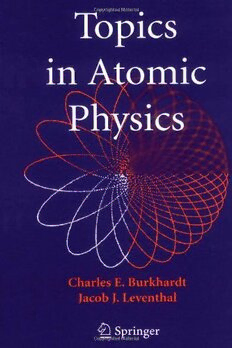Table Of ContentTopics in Atomic Physics
Charles E. Burkhardt
DepartmentofPhysics,St.LouisCommunityCollege,
St.Louis,Missouri
Jacob J. Leventhal
DepartmentofPhysics,UniversityofMissouri—St.Louis,
St.Louis,Missouri
Topics in Atomic Physics
With75Illustrations
CharlesE.Burkhardt JacobJ.Leventhal
DepartmentofPhysics DepartmentofPhysics
St.LouisCommunityCollege UniversityofMissouri—St.Louis
St.Louis,MO63121 St.Louis,MO63121
USA USA
LibraryofCongressControlNumber:2005926818
ISBN10:0-387-25748-9
ISBN13:978-0387-25748-8
Printedonacid-freepaper.
(cid:1)C 2006SpringerScience+BusinessMedia,Inc.
Allrightsreserved.Thisworkmaynotbetranslatedorcopiedinwholeorinpartwithoutthewritten
permissionofthepublisher(SpringerScience+BusinessMedia,Inc.,233SpringStreet,NewYork,
NY10013,USA),exceptforbriefexcerptsinconnectionwithreviewsorscholarlyanalysis.Use
in connection with any form of information storage and retrieval, electronic adaptation, computer
software,orbysimilarordissimilarmethodologynowknownorhereafterdevelopedisforbidden.
Theuseinthispublicationoftradenames,trademarks,servicemarks,andsimilarterms,evenifthey
arenotidentifiedassuch,isnottobetakenasanexpressionofopinionastowhetherornottheyare
subjecttoproprietaryrights.
PrintedintheUnitedStatesofAmerica. (TB/EB)
9 8 7 6 5 4 3 2 1
springeronline.com
Helen,Charlie,Sarah,andMichelle
Bette,Steve,Andy,Dan,andTina
Preface
The importance of the field of atomic physics to modern technology cannot be
overemphasized.Atomicphysicsservedasamajorimpetustothedevelopmentof
the quantum theory of matter in the early part of the twentieth century and, due
totheavailabilityofthelaserasalaboratorytool,ithastakenusintothetwenty-
first century with an abundance of new and exciting phenomena to understand.
Ourintentioninwritingthisbookistoprovideafoundationforstudentstobegin
researchinmodernatomicphysics.Asthetitleimplies,itisnot,norwasitintended
tobe,anall-inclusivetomecoveringeveryaspectofatomicphysics.
Any specialized textbook necessarily reflects the predilection of the authors
towardcertainaspectsofthesubject.Thisoneisnoexception.Itreflectsourbe-
liefthatathoroughunderstandingoftheuniquepropertiesofthehydrogenatom
is essential to an understanding of atomic physics. It also reflects our fascina-
tionwiththedistinguishedpositionthatMotherNaturehasbestowedonthepure
CoulombandNewtonianpotentials,andthushydrogenatomsandKeplerianor-
bits.Therefore,wehavedevotedalargeportionofthisbooktothehydrogenatom
toemphasizethisdistinctiveness.Weattempttostresstheuniquenessoftheattrac-
tive1/rpotentialwithoutdelvingintogrouptheory.Itisourbeliefthat,oncean
understanding of the hydrogen atom is achieved, the properties of multielectron
atomscanbeunderstoodasdeparturesfromhydrogenicproperties.
From the beginning, it was our intention to include information in this book
thatisnoteasilylocatedelsewhere.Thus,whilethebookcanbeusedasatext,it
ishopedthatitwillalsobeausefulreference.Tothisend,wehaveincorporated
derivationsthataredifficulttofindinotherbooksand,indeed,evenintheliterature.
Forexample,thequantummechanicalLenzvectoroperatorisnotoftendiscussed
in books on quantum mechanics and atomic physics. When it is discussed, it is
usually stated that it commutes with the hydrogen atom Hamiltonian, but it is
difficulttoprove.However,thisbookgivesthisproofinsomedetail.Infact,one
ofthegeneralfeaturesofourbookisthatweoftenincludemorealgebraicsteps
than are traditionally given in textbooks. By doing this, we wish to relieve the
readerofthetediumofreproducingalgebraand,thus,permitconcentrationonthe
physics.
vii
viii Preface
Thismaterialisintendedtobesuitableforaone-semestergraduateoradvanced
undergraduate-levelcourseinatomicphysics.Itisassumedthatthestudenthashad
atleastintroductoryquantummechanics,althoughpertinenttopicssuchaspertur-
bationtheoryandvariationaltechniquesarebrieflyreviewed.Chapter1presents
somebackgroundmaterialwhich,inlargepart,isreview.Inthischaptertheutility
oftheBohratomisdiscussedandthederivationperformedasBohrdidit.Thisis
incontrasttomostmodernpresentations.Chapters2and3arestandardreviewsof
angularmomentumalgebrawithemphasisonaspectspertinenttoatomicphysics.
Chapter4isadiscussionofthequantummechanicalhydrogenatomandthesep-
aration of the Schrödinger equation in both spherical and parabolic coordinates.
Emphasis is placed on the conditions that force quantization. This chapter also
includes an attempt to clarify the difference between two commonly used defi-
nitions of Laguerre and associated Laguerre polynomials. In most treatments of
thequantummechanicalhydrogenatom,nomentionismadeofalternatedefini-
tionsofthesespecialfunctions.Chapter5isadiscussionoftheclassicalhydrogen
atom.NaturallyitdrawsheavilyonKeplerianorbitsandtheconsequencesofthe
additionalconstantoftheclassicalmotion,theLenzvector.Chapter6discusses
theaccidentaldegeneracyofthehydrogenatomanditscausesinthecontextofthe
quantum mechanical analog of the Lenz vector. To our knowledge, the material
in Chapter 6 is not covered in any modern text. Chapter 7 discusses the break-
ingoftheaccidentaldegeneracyviafinestructure,theLambshift,andhyperfine
structure.Thetreatmentisfairlystandard.Chapter8treatsthehydrogenatomin
externalfields.ThedescriptionoftheZeemaneffectisstandard,buttheweakfield
Stark effect is described in quantum mechanically and classically. The classical
treatmentleansheavilyontheresultsofChapter5whilethequantummechanical
treatmentexploitstheoperatorformalismdevelopedinChapter6.
Chapters9and10arediscussionsofmultielectronatoms,beginningwithhelium
inChapter9.Thepresentationisquitestandard.Chapter11presentsthequantum
defect in a way that is seldom seen in texts. In keeping with the theme of this
book,thequantumdefectisrelatedtoclassicalconceptsandthecorrespondence
principle.Chapter12dealswithmultielectronatomsinexternalfields.Hereagain
the Zeeman effect is treated in the standard manner, but the Stark effect is pre-
sentedinawaythatleansheavilyonthematerialpresentedinChapter11.Finally,
in Chapter 13, radiation is discussed at length. We emphasize how the concept
of a stationary state is not at odds with the classical concept of radiation from
acceleratingcharges.Otherwise,thepresentationinthischapterisstandard,but,
wehope,thorough.
SIunitsareusedexceptinthoseinstancesforwhichwebelievethatatomicunits
areconsiderablymoreconvenient.Forinstance,theZeemaneffectistreatedusing
SIunitsbecausetheBohrmagnetontimesthemagneticinductionfieldprovides
aconvenientmeasureoftheZeemanenergy.However,wefindatomicunitstobe
moreconvenientinthetreatmentoftheStarkeffect.
There are more than eighty problems listed at the ends of chapters, with se-
lected answers given at the end of the book. Some are merely exercises, but
others are more challenging. A few are derivations of results that are used later
Preface ix
in the book. A detailed solutions manual, in many cases showing more than
one way to solve a given problem, is available to qualified instructors: visit
www.springeronline.com/0-387-25748-9.
AlistofcorrectionstothebookisavailableontheInternetat:
http://www.umsl.edu/jjl/homepage/
and
http://www.stlcc.edu/fv/physics/CBurkhardt/
Comments or previously unreported errors can be transmitted to the authors
throughtheseWebsites.
We wish to thank our graduate students Joseph F. Baugh, Marco Ciocca, and
Lucy Wenzhong He. Thanks are also due to the numerous undergraduates who
have worked in the UMSL Atomic Physics Laboratory over the past 40 years.
We also wish to acknowledge the contributions of our many collaborators and
ourUMSLcolleagues,Ta-PeiCheng,WayneP.Garver,andPhilipB.Jameswith
whomwehadmanyvaluablediscussionsovertheyears.
ThanksalsotoWai-YimChingofUMKCformanyvaluablecommentsonthe
manuscriptduringitspreparation.
CharlesE.Burkhardt
JacobJ.Leventhal
Contents
Preface................................................................................. vii
Chapter1 Background............................................. 1
1.1 Introduction..................................................................... 1
1.2 TheBohrModeloftheAtom................................................ 1
1.3 NumericalValuesandtheFineStructureConstant...................... 7
1.4 AtomicDimensions—Isa aReasonableAtomicDiameter?......... 8
0
1.5 LocalizingtheElectron:IsaPointParticleReasonable?............... 10
1.6 TheClassicalRadiusoftheElectron....................................... 11
1.7 AtomicUnits.................................................................... 11
Chapter2 AngularMomentum.................................. 14
2.1 Introduction..................................................................... 14
2.2 Commutators.................................................................... 18
2.3 AngularMomentumRaisingandLoweringOperators................. 20
2.4 AngularMomentumCommutationRelationswith
VectorOperators............................................................... 25
2.5 MatrixElementsofVectorOperators...................................... 26
2.6 EigenfunctionsofOrbitalAngularMomentumOperators............. 29
2.7 Spin............................................................................... 33
2.8 TheStern–GerlachExperiment.............................................. 41
Chapter3 AngularMomentum—TwoSources.............. 46
3.1 Introduction..................................................................... 46
3.2 TwoSetsofQuantumNumbers—UncoupledandCoupled............ 46
3.3 VectorModelofAngularMomentum...................................... 51
3.4 ExamplesofCalculationoftheClebsch–GordanCoefficients........ 55
3.5 HyperfineSplittingintheHydrogenAtom................................ 61
xi
xii Contents
Chapter4 TheQuantumMechanicalHydrogenAtom.... 73
4.1 TheRadialEquationforaCentralPotential.............................. 73
4.2 SolutionoftheRadialEquationinSpherical
Coordinates—TheEnergyEigenvalues.................................... 75
4.3 TheAccidentalDegeneracyoftheHydrogenAtom..................... 77
4.4 SolutionoftheHydrogenAtomRadialEquationin
SphericalCoordinates—TheEnergyEigenfunctions.................... 79
4.5 TheNatureoftheSphericalEigenfunctions.............................. 82
4.6 SeparationoftheSchro¨dingerEquationin
ParabolicCoordinates......................................................... 82
4.7 SolutionoftheSeparatedEquationsinParabolic
Coordinates—TheEnergyEigenvalues.................................... 85
4.8 SolutionoftheSeparatedEquationsinParabolic
Coordinates—TheEnergyEigenfunctions................................ 87
Chapter5 TheClassicalHydrogenAtom..................... 92
5.1 Introduction..................................................................... 92
5.2 TheClassicalDegeneracy.................................................... 95
5.3 AnotherConstantoftheMotion—TheLenzVector..................... 97
Chapter6 TheLenzVectorandthe
AccidentalDegeneracy............................................... 105
6.1 TheLenzVectorinQuantumMechanics.................................. 105
6.2 LenzVectorLadderOperators;ConversionofaSpherical
EigenfunctionintoAnotherSphericalEigenfunction................... 109
6.3 ApplicationofLenzVectorLadderOperatorstoa
GeneralSphericalEigenfunction............................................ 114
6.4 ANewSetofAngularMomentumOperators............................ 116
6.5 EnergyEigenvalues............................................................ 118
6.6 RelationsBetweentheParabolicQuantumNumbers................... 120
6.7 RelationshipBetweentheSphericaland
ParabolicEigenfunctions..................................................... 122
6.8 AdditionalSymmetryConsiderations...................................... 123
Chapter7 BreakingtheAccidentalDegeneracy............ 126
7.1 Introduction..................................................................... 126
7.2 RelativisticCorrectionfortheElectronicKineticEnergy.............. 127
7.3 Spin-OrbitCorrection......................................................... 128
7.4 TheDarwinTerm.............................................................. 130
7.5 EvaluationoftheTermsThatContributetotheFine-Structure
ofHydrogen..................................................................... 130
Contents xiii
7.6 TheTotalFine-StructureCorrection........................................ 135
7.7 TheLambShift................................................................. 137
7.8 HyperfineStructure............................................................ 139
7.9 TheSolutionoftheDiracEquation......................................... 142
Chapter8 TheHydrogenAtominExternalFields......... 145
8.1 Introduction..................................................................... 145
8.2 TheZeemanEffect—TheHydrogenAtominaConstant
MagneticField.................................................................. 146
8.3 WeakElectricField—TheQuantumMechanicalStarkEffect........ 159
8.4 WeakElectricField—TheClassicalStarkEffect........................ 171
Chapter9 TheHeliumAtom..................................... 178
9.1 IndistinguishableParticles.................................................... 178
9.2 TheTotalEnergyoftheHeliumAtom..................................... 180
9.3 EvaluationoftheGroundStateEnergyoftheHeliumAtom
UsingPerturbationTheory................................................... 183
9.4 TheVariationalMethod....................................................... 186
9.5 ApplicationoftheVariationalPrincipletotheGround
StateofHelium................................................................. 187
9.6 ExcitedStatesofHelium..................................................... 189
9.7 DoublyExcitedStatesofHelium:Autoionization....................... 192
Chapter10 MultielectronAtoms................................ 196
10.1 Introduction..................................................................... 196
10.2 ElectronConfiguration........................................................ 196
10.3 TheDesignationofStates—LSCoupling................................. 198
10.4 TheDesignationofStates—jjCoupling................................... 207
Chapter11 TheQuantumDefect............................... 214
11.1 Introduction..................................................................... 214
11.2 EvaluationoftheQuantumDefect.......................................... 216
11.3 ClassicalFormulationoftheQuantumDefectandthe
CorrespondencePrinciple.................................................... 220
11.4 TheConnectionBetweentheQuantumDefectandthe
RadialWaveFunction......................................................... 225
Chapter12 MultielectronAtomsinExternalFields....... 230
12.1 TheStarkEffect................................................................ 230
12.2 TheZeemanEffect............................................................. 238

